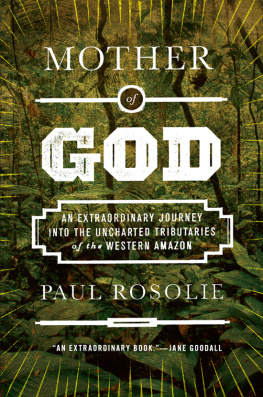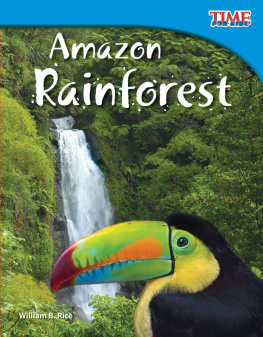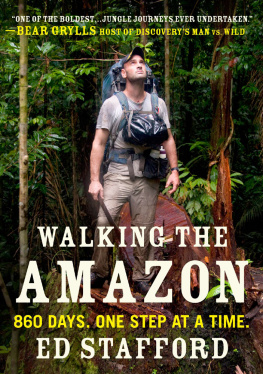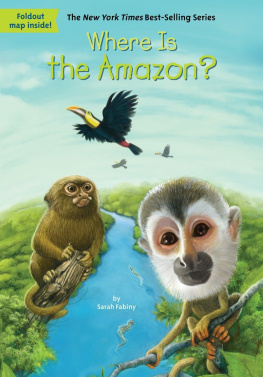To my parents, Ed and Lenoreyou have given me everything.
CONTENTS
I n January 2006, just eighteen years old, restless, and hungry for adventure, I fled New York and traveled to the west Amazon. With a satellite phone that my worried parents had insisted on renting, and a camera I had borrowed from a friend, I was indistinguishable from any of the scientists and tourists aboard that first flight. In all likelihood, like them, I would spend my three weeks in the jungle, and then return forever to my life back home. There was no way to know I was beginning a journey that would span a decade and take me to some of the most inaccessible reaches of the Amazon River at the most crucial moment in its history.
It has been a journey filled with unfathomable beauty and brutality that sounds more like fiction than fact: lost tribes, floating forests, murdering bandit-loggers killed by arrows, insectivorous slashing giants, and a secret Eden. There would be fistfights, stickups, and beheadings; new species discovered, fossils unearthed, and people riding on giant snakes. I would see places that no one had seen before, and cultivate a unique relationship with the secret things of the Amazonian wild.
I wrote this book careful to avoid it becoming a scientific text, or historical summary of the Amazonother authors have written such volumes far better than I ever could. Instead, I chose to focus on the extremes of adventure, and the beauty of wildlife and natural systems. The events in the pages ahead are written as I experienced them. Aside from changing a few names, dates, and geographic details to protect people and places, everything that follows is true.
The few remaining unknown places of the world exact a price for their secrets.
C OLONEL P ERCY F AWCETT
B efore he died, Santiago Durand told me a secret. It was late at night in a palm-thatched hut on the bank of the Tambopata River, deep in the southwestern corner of the Amazon Basin. Beside a mud oven, two wild boar heads sizzled in a cradle of embers, their protruding tusks curling in static agony as they cooked. The smell of burning cecropia wood and singed flesh filled the air. Woven baskets containing monkey skulls hung from the rafters, where stars peeked through gaps in the thatching. A pair of chickens huddled in the corner, conversing softly. We sat facing each other on sturdy benches, across a table hewn from a single cross section of some massive tree, now nearly consumed by termites. The songs of a million insects and frogs filled the night. Santiagos cigarette trembled in his aged fingers as he leaned close over the candlelight to describe a place hidden in the jungle.
He said it was a place where humans had never been. Between rivers and isolated by a quirk of geography, it had remained forgotten through the centuries. The only tribes who knew of the land had regarded it as sacred and never entered, and so it had remained untouched for millennia. Decades earlier, after weeks of travel up some nameless tributary, Santiago had come to its border. There, he said, you could watch jaguars sunning themselves on open beaches in the morning; harpy eagles haunted the canopy and flocks of macaws filled the sky like flying rainbows. The river was so thick with fish that you could scoop up dinner with your bare hands. What he described was a lost world. He told me that it was the wildest place left on earth.
Don Santiago, as I knew him, even at the age of eighty-seven, would often spend months out in the jungle alone. He knew the medicinal properties of every herb, orchid, and sap in the jungle that surrounded the small indigenous community where he lived, in the lowlands of southeast Peru. He possessed an insight to the secrets of the forest greater than anyone I have met. He had lived in the jungle before boat motors or chain saws were available, before Spanish extinguished the native dialect of his people. Over the course of a long life in Amazonia hed seen tribes that most people didnt know existed and species yet to be described to science. As he spoke of the jungles secrets, lore of an age nearly ended, candlelight reflected from within shrouded sockets, the map of tributaries in his weathered face as cryptic as the landscape in which it was wrought.
I knew from experience that Don Santiago was never wrong, and in the years to come what he said had a profound effect on my life. As a naturalist, I knew that finding and sampling a truly isolated area of rainforest could redefine the baselines scientists use to study wildlife, and help me to protect habitat. As an explorer, it was the ultimate mission, and planning an expedition to find the lost world Don Santiago described became an obsession for years to come. But what kept me awake at night was something deeper than academic discovery or adventure. It was the realization that we could be the last generation to live in a world where such places exist.
I knew that it was a journey I had to make, and I knew I had to make it alone. If the place Santiago had described really did exist, as pristine and hidden as he had said, there was no chance I was going to foul the silence with the pollution and din of an entire expedition team: motors, voices, fuel. For a long time I struggled to work up the nerve. Even after having worked years in Amazonia when living in the bush had become second nature, the thought of going it alone made me shiver. There were too many stories, too many hundreds of would-be explorers, lost tourists, and even locals, who were swallowed by the jungle each year never to be seen again. In the most savage and dizzyingly vast wilderness on earth, the rule is simple: never go out alone. Yet there are those among us who have difficulty accepting what we have not found out for ourselves, who pass a WET PAINT sign and cannot help touching the wall. We simply have to know .
Only months after Don Santiago told me his secret, there I was: a hundred miles from the most remote human outpost, in utterly untouched, untrailed jungle. I was completely lost and terrified. I looked up hoping to see blue, but the entire sky had been eclipsed for days. From beneath 150 feet of canopy, the view above was a churning mess of understory vegetation, vines, bromeliads, and towering pillars of ancient trees swaying menacingly in the hot wind. In the Amazon less than 5 percent of sunlight reaches the forest floor on a clear day, which this was not. Black storm clouds lay pregnant across the canopy so low that vapor and branches intermingled.
I walked fast, machete in one hand and compass in the other, praying to glimpse a gap in the foliage that would signal the salvation of the open river. Earth, forest, and sky were all fiercely animated and moving in concert. Twigs and leaves, Brazil nuts, and even small animals rained from above. Trees as thick as school buses buckled and groaned, shaking the earth as the wind tore at their branches. I felt trapped. I longed to see open space. Id been lost for days.
The storm was gathering force and my heart was pounding. One hundred feet to my right a branch the size of a mature oak snapped and hit the earth with the force of a car crash. More than once a cannon blast sounded as an entire tree split and fell. In the Amazon large trees are meant to topple, opening gaps for light, which allows new vegetation to flourish, while the carcasses of the fallen giants are digested by legions of insects, fungi, and proteins. Its how the jungle works; its a giant meat grinder. When you are in it, youre part of that system, part of the food chain.
If the storm intensified, there was little chance Id survive the resulting carpet bombing of shed tree limbs. Some of the great explorers have claimed that snakes or piranhas or jaguars present the gravest threat in the Amazon, but these declarations betray inexperience. The trees themselves, in their dizzying innumerability, isolate and disorient you, and in a storm prove the most deadly. Some of the true giants are so interlaced with vines and strangler tentacles that when they fall, their weight tears down almost an acre of jungle. There is no way to escape.











